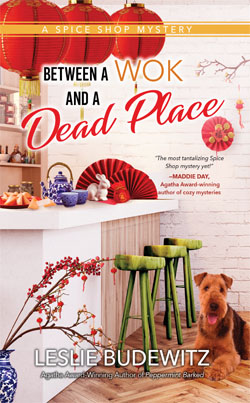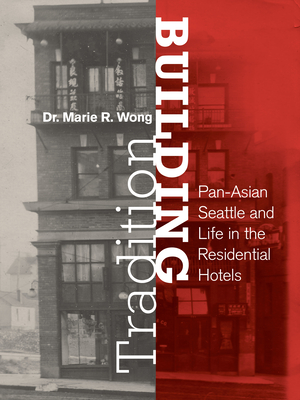(With the Lunar New Year approaching, I went to the blog in search of this post to share it again and discovered I’d never posted it! But if you enjoy a bit of seasonal reading, then the timing is just right!)
Spice Shop readers tell me they love spotting names of books and authors they recognize and potential new reads on Pepper’s bookshelves, both in her loft and in the shop. And Pepper and Kristen, who handles most of the Spice Shop’s book buying, love creating seasonal book displays.
For the Lunar New Year, they’ve set out several foodie cozies with an Asian theme: Vivian Chien’s noodle shop mysteries, Jennifer Chow’s LA Night Market series, and Mia Manamsala’s Tita Rosie’s Kitchen mysteries, set in a family-run Filipino restaurant. I have read and enjoyed them all. And I’ll confess that I’m the customer who told them about The Last Chinese Chef by Nicole Mones, a fascinating novel about an American food reporter who meets a Chinese-American chef in China, a man determined to keep alive an intricate, formal style of Chinese cooking far beyond what most of us can imagine.
Pepper forges a working relationship with the owner of the new cheese shop in the Market, Say Cheese!, and seals it by giving her copies of For Cheddar or Worse by Avery Aames and Cheddar Off Dead by Korina Moss, both mysteries set in cheese shops. Food puns rule.
The staff steered customers planning a trip to France to cookbooks by two American food writers who focus on French food, David Liebovitz and Dorie Greenspan, along with a shop favorite, The French Country Table: Simple recipes for bistro classics, by Laura Washburn. Not coincidentally, all are favorites in our home.
The book Lena insists Pepper read is The Hotel on the Corner of Bitter and Sweet by Jamie Ford, set in Seattle’s Chinatown during World War II and the present day.
I discovered some terrific resources in my research, mentioned in the acknowledgments: Building Tradition: Pan-Asian Seattle and Life in the Residential Hotels, by Marie Rose Wong, Ph.D., an account not just of the CID’s residential hotels but of the economic, political, and social forces that shaped it.
Two books provided helpful personal accounts, photographs, and historical research: Divided Destiny: A History of Japanese Americans in Seattle by David Takami, and Reflections of Seattle’s Chinese Americans: The First 100 Years by Ron Chew and Cassie Chin.
I was totally absorbed by the memoir Long Way Home: Journeys of a Chinese Montanan by Flora Wong and Tom Decker. The experience of American-born Flora, whose daughter is a friend of ours, in returning to China as a small child in the 1930s, enduring tremendous hardship on a small family farm, then returning to the US in the late 1940s through an arranged marriage pulled together all I had read, and helped me understand more about the hardships of life in China and the tug that many immigrants felt, even after making the difficult decision to leave.
Another interesting reference, though one I barely dipped into, is Herbs and Roots: A History of Chinese Doctors in the American Medical Marketplace, Tamara Venit-Shelton, Ph.D. And while not part of my research, some readers may be intrigued by The Middle Kingdom Under the Big Sky: A History of the Chinese Experience in Montana by Mark T. Johnson. Both Professor Venit-Shelton and Professor Johnson speak widely about their research, and videos of their talks are available on YouTube and elsewhere on the Internet.
Finally, I always learn something interesting from Seattle Walks: Discovering History and Nature in the City by David B. Williams.
The murder is fiction. The food is fact.



